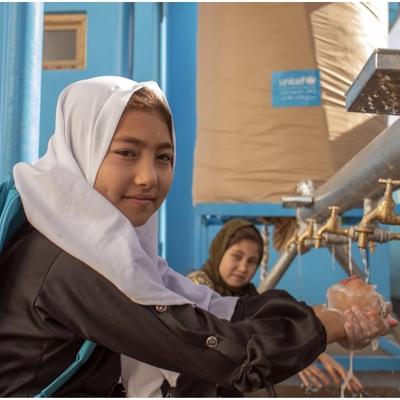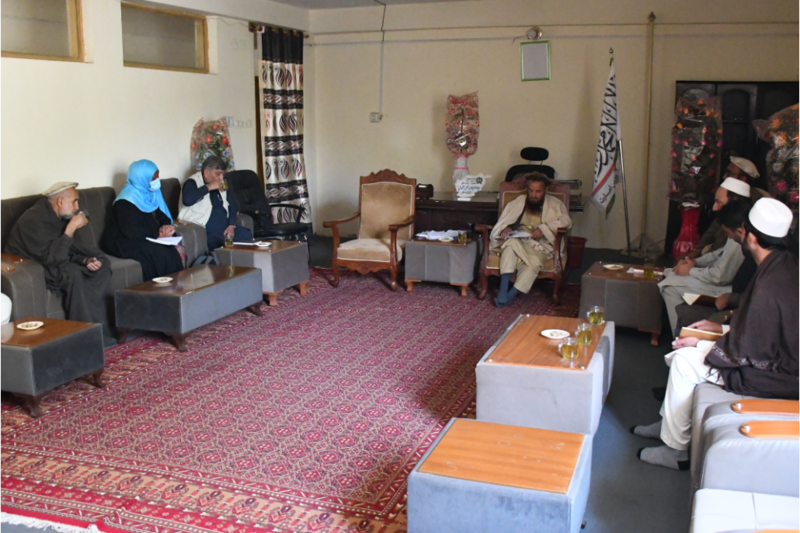
In Chardei Village, Batikot District, Nangarhar Province, Afghanistan, poor sanitation has been a key factor in recurring polio cases. In 2024, UNICEF's WASH and Polio programs collaborated with WHO and local leaders to improve sanitation and hygiene, aiming to disrupt polio transmission. This integrated approach went beyond vaccination, addressing community-driven hygiene initiatives to reduce the spread of the virus in vulnerable areas. These efforts led to inspiring results: handwashing practices surged from just 13% to an incredible 95%, water treatment rose dramatically from 15% to 93%, and latrine use increased from 30% to 70%, positively impacting over 1,300 families.
Photo: Young girls practice handwashing, showcasing how improved WASH practices foster healthier futures for Afghan children. UNICEF/Afghanistan/Khayyam
Chardei Village, located in Batikot District, Nangarhar Province, Afghanistan, has struggled with recurring polio cases due to poor sanitation. In 2024, UNICEF's WASH and Polio programs collaborated with WHO and local leaders to enhance sanitation and hygiene, aiming to curb the spread of poliovirus. This initiative focused on a comprehensive intervention beyond just vaccinations, integrating community-driven hygiene solutions to reduce the spread of the virus in vulnerable areas.
The collaboration between UNICEF's WASH and Polio programs, WHO, and local stakeholders aimed to tackle the root causes of polio transmission in Chardei Village. Chardei was part of an Environmental Sample Collection site and faced significant sanitation challenges, with open sewers and contaminated shallow wells that served as the main water source. These conditions provided a breeding ground for the poliovirus, evidenced by a reported case of wild poliovirus in a four-year-old girl in 2023.
Challenges and Strategy
Baseline assessments highlighted severe sanitation issues: poor waste disposal, open defecation, and widespread contamination of drinking water. Only 30% of households had access to proper sanitation facilities. Globally, evidence shows that poor hygiene is directly linked to polio spread. Inadequate sanitation facilitates the transmission of the virus, which is primarily spread through feces in environments lacking proper hygiene practices. Poliovirus can survive for weeks in contaminated water and soil, making the risk persistent for unimmunized individuals. Therefore, controlling open defecation and improving hygiene practices were critical.
Community-Led Total Sanitation (CLTS) Approach
To address these challenges, the Community-Led Total Sanitation (CLTS) approach was used to foster community ownership and responsibility. CLTS encouraged community members to eliminate open defecation and adopt better hygiene practices. Local elders, trained facilitators, and community leaders played essential roles, ensuring that solutions were culturally appropriate and sustainable. Key activities included constructing latrines, promoting safe water storage, and conducting educational sessions on handwashing with soap.

Photo: Community leaders proudly hold certificates after sanitation training, highlighting the power of local leadership in tackling polio. UNICEF/2024/Afghanistan
Additionally, various supplies were distributed to support these efforts, benefiting more than 1,300 families. Each family received jerrycans for safe water storage, and chlorine tablets were provided to purify drinking water, ensuring access to clean water. Soap was distributed to promote regular handwashing, which is crucial for preventing disease spread. To further support these activities, educational materials were provided, including leaflets on water treatment, emergency booklets, and handwashing guides. Community engagement was enhanced through the use of flipcharts during sessions led by CLTS and Family Health Action Groups, making the information accessible and easy to understand.
Supplies for Batikot Polio WASH integrated intervention |
|||||||||
|
Category |
Family |
Jerrycans (two per family) |
Chlorine tablets of 33mg |
Soap (21 bar soaps per family) |
Leaflet, Water treatment |
Leaflet, Chlorine USE |
Emergency booklets |
Handwashing booklet |
WASH flip-chart for the CLTS and FHAG |
|
Team 1 |
366 |
732 |
461,160 |
5,124 |
732 |
732 |
732 |
732 |
0 |
|
Team2 |
318 |
636 |
400,680 |
4,452 |
636 |
636 |
636 |
636 |
0 |
|
Team 3 |
336 |
672 |
423,360 |
4,704 |
672 |
672 |
672 |
672 |
0 |
|
Team 4 |
303 |
606 |
381,780 |
4,242 |
606 |
606 |
606 |
606 |
0 |
|
Schools |
|
0 |
0 |
1,000 |
100 |
100 |
1,000 |
1,000 |
0 |
|
health facility |
|
0 |
0 |
1,000 |
100 |
100 |
1,000 |
1,000 |
0 |
|
CLTS office |
7 |
2 |
1,890 |
50 |
50 |
50 |
50 |
50 |
200 |
|
Total |
1,323 |
2,646 |
1,668,870 |
20,572 |
2,896 |
2,896 |
4,696 |
4,696 |
200 |
Community Meeting with Authorities
Local community leaders and UNICEF representatives in discussion with regional authorities. This meeting reflects the collaboration between community, government, and international organizations to address sanitation and health issues in the fight against polio in Afghanistan.
Photo: UNICEF and local authorities discuss integrated efforts to improve hygiene, emphasizing the value of joint action. UNICEF/2024/Afghanistan

Results and Impact
The initiative led to remarkable improvements. Initially, only 13% of the community practiced handwashing at critical times, and 15% treated their drinking water. After three months, handwashing increased to 95%, water treatment rose to 93%, and latrine use improved from 30% to 70%. The integration of the WASH network with WHO's polio micro plans allowed efficient use of resources and significantly benefited over 1,300 children and families.

The success of the initiative also demonstrated the value of integrating WASH and Polio efforts for effective service delivery. The WASH program's existing community structures were instrumental, enabling the Polio program to leverage well-established networks without creating new ones. This approach reflected the best practices seen in other countries, like Somalia, where integrating polio outreach with sanitation promotion has been crucial in combating the virus (UNICEF, 2015).
Community Engagement and Lessons Learned
Community engagement was pivotal to the initiative's success. Local elders and facilitators conducted educational sessions that emphasized culturally relevant, community-approved hygiene practices. This approach ensured that the community felt ownership of the process. The collaboration between WASH and Polio teams showed that tackling polio requires addressing broader issues such as hygiene and sanitation, not just vaccination. The community's positive response showed that they valued an approach addressing their holistic needs – more than just vaccination, but improving daily health conditions.
The partnership between the Polio and WASH programs has been lauded as a model of integrated service delivery. By leveraging existing WASH structures, the program addressed sanitation issues efficiently and sustainably. The CLTS approach ensured that the improvements were community-driven and had the potential for long-term sustainability.
The integration of WASH and Polio programs in Chardei Village demonstrates how combining efforts across sectors can significantly improve health outcomes. UNICEF is enhancing integrated service delivery (ISD) to address the diverse needs of children in high-risk areas. The goal is not only to reduce the number of missed children in polio campaigns but also to improve overall health and nutrition outcomes for children. This commitment to an integrated approach brings together WASH, nutrition, health, and Social and Behavior Change (SBC) activities, ensuring low-cost, high-impact interventions that significantly improve outcomes for children.
Experience from Afghanistan, Somalia and other countries shows that integrating polio and WASH programs effectively reduces open defecation and improves hygiene, which is crucial for limiting the spread of poliovirus. In Chardei, focusing on both vaccination and sanitation yielded better results than focusing on one alone. UNICEF aims to expand this integrated service delivery approach to reach more high-risk areas, combining WASH, nutrition, health, and SBC activities for low-cost, high-impact interventions. The improvements in Chardei highlight the power of community-driven efforts supported by targeted health measures in achieving lasting health benefits.
Writen by Daria Shubina, UNICEF NY HQ Polio SBC Knowledge Management Specialist

